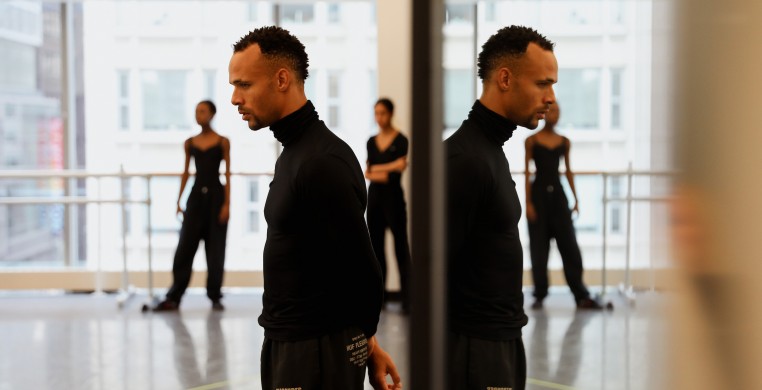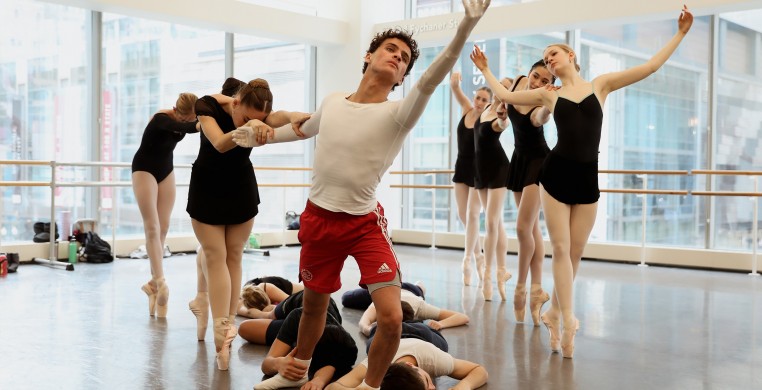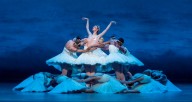The Joffrey Ballet will once again present the “Winning Works” choreography competition and performance beginning March 16 at the Museum of Contemporary Arts. The competition is a call for ALAANA artists— African, Latinx, Asian, Arab and Native America—to submit work to be performed by the Joffrey Academy Trainees and Studio Company, set to a commissioned score by a composer/collaborator.
Since the program’s inception in 2000, it has grown to become one of the most impactful components of the organization. "The Joffrey Ballet's Winning Works program exemplifies a 'Joffrey for All' and our steadfast commitment to ALAANA artists," says Greg Cameron, The Joffrey Ballet President and CEO in a statement to the press. "Winning Works creates more than what we see on stage; it opens an opportunity. This program is integral to the Joffrey's commitment to uplifting emerging choreographers and our Academy dancers.”
The 2023 winners are Kameron Saunders, Mike Tyus, Christopher D’Ariano and Natasha Adorlee. The subject matter chosen by each artist varies greatly—from sandcastles to pugilism. Each artist lends themself to the experimental nature of the program. In interviews with SeeChicagoDance, the artists expand on their vision of each new work.
Kameron Saunders is not from Chicago but may be recognizable from his appearance in the Disney+ film “Spirited,” starring Will Farrel and Ryan Reynolds, and choreographed by Chloe Arnold, or from performances with such musical artists as Lizzo and Saucy Santana.
Saunders’ “Warmer” is inspired by the book “All About Love” by bell hooks set to music composed by Brandon Finklea, a former collaborator of Saunders and sound engineer for the K-pop group, “Blackpink.”
Saunders describes the work as “An abstract work that looks at the love between relationships, whether that is romantic, family, friends… What does it look like when there is an absence of love? When we are absent of vulnerability, communication and honesty with the people around us.”
 Kameron Saunders instructs a dancer for his work "Warmer" for Joffrey's "Winning Works"; Photo byCarolyn McCabe
Kameron Saunders instructs a dancer for his work "Warmer" for Joffrey's "Winning Works"; Photo byCarolyn McCabe
Saunders uses ballet, West African, Hip Hop and contemporary dance styles to build a work that grows “warmer” as it progresses, in costume color, lighting design and intensity of movement. “It has a lot of upright, fixed position that almost feels balletic,” said Saunders. “In an effort to parallel this rigidness that can happen from person to person, if we are honest with ourselves…by the end of the work it is much more grounded, more use of the spine, much more floor work, more partnering, a couple moments in the work where the partnering is almost like taboo—the music does this large swell the male touches the female’s back, she stares at his hand, then slowly back at him, the music is swelling large…physically it does progress, lots of moving.”
Los Angeles-based Mike Tyus is no stranger to Chicago, or at least his choreography isn’t, with work having been set on both Visceral Dance Chicago and Chicago Repertory Ballet just last year.
“Sweet Science” is based on Tyus’ experience growing up as a boxer descended from a long line of pugilists. “This work grew out of a conversation I had with my father,” said Tyus. “My grandfather, his father, had just passed away and it was a ‘lineage of fathers’ conversation. My great grandfather was a boxer in Decatur and Chicago. He won every fight he got. My father made me box when I was younger to defend myself, which was kind of a tactic to be with me, like a father and son bonding experience.”
But Tyus explains that this father-son bonding came with caveats. “We didn’t have the best relationship growing up, and my grandfather and his father didn’t have a relationship at all; there’s this interesting masculine dynamic and this dysfunctional father figure-as-boxer who keeps coming up in my life as an archetype.”
Tyus explains how he wanted to show the dancers what happens in practice at a boxing gym, and taught them concrete boxing fundamentals, then translated them to the abstract world of dance. “There’s a moment where the hands circle each other quickly like they’re hitting a speed bag. We played with the feeling of being hit in the head or the face, and what it would do to your physical form as movement. We played with the idea of what a punching bag feels like swinging. I love the feeling of arms swinging around ape-like, more like a brawl then a technical boxing match.”
The work will be performed to a composition by composer and assistant choreographer Luca Renzi. “Luca was designing the score while helping me choreograph,” explains Tyus. “We took a sound bite of Manny Paquin doing a speedbag. It sounds like some crazy rave music! He took that sound clip, altered it, and put it in the sound score. We took the sound of a boxing gym and used it as atmospheric, ambient music.”
The name “Sweet Science” comes from a lesser-known nickname for boxing, or as Tyus explains, “They call it ‘the sweet science’ because of how technical you have to be, what a science it is to be a fighter—it’s not all about brute force and strength—but about technicality, strategy and intelligence.”
 Mike Tyus, recipient of the Zach Lazar Winning Works Fellowship and choreographer of "Sweet Science" for "Winning Works"; Photo by Carolyn McCabe
Mike Tyus, recipient of the Zach Lazar Winning Works Fellowship and choreographer of "Sweet Science" for "Winning Works"; Photo by Carolyn McCabe
“Overture No.7: Inter Nos” presented by multidisciplinary artist Christopher D’Ariano explores the relationship between the conductor and an orchestra ((OMIT:of musicians)), with a score by Thomas Nickell and Fiona Stocks-Lyons. D’Ariano explains that “It’s about this close relationship that the creator has to their medium and what it means to them in their own imaginative mind.”
The work features the company of dancers dressed androgynously—men topless and women in flesh-colored leotards—which has become a recurring theme in D’Ariano’s work. Instead of focusing on gender differentiation, D’Ariano has the dancers moving as a collective, like how symphony musicians must play in harmony with one another, with the conductor holding it all together.
D’Ariano describes a dramatic part of the work: “The first dance movement has the conductor attached by their arms and legs to the dancers as orchestra. The dancers become a sticky web of strings; for me, that moment is impactful, because you can see the connection between what the creator/conductor is trying to emote and build before our eyes. Eventually, [the dancers] are released from the ensemble and the piece unravels… it’s the most dramatic moment in the piece!”
And yet, there is room for individual expression. Not every dancer is a monolith. “The dancers are in pointe and flat shoes,” describes D’Ariano, and it goes from more classical to a lot more contemporary based on the character and the role that each person has in the ballet. It’s not one definitive style, it’s multiple genres of ballet mixed into one.”
San Francisco-based dancer and choreographer Natasha Adorlee presents “Momoda,” a work based on the existential nature of life being created and destroyed, ebbing and flowing, explored through a familiar medium. “I did a lot of study about how sand interacts with water, looking at natural formations, how it could build and dissolve structure,” say Adorlee. A lot of the movement vocabulary in the piece comes from those experiments.”
“Conceptually, I am exploring the idea of impermanence in different states that we inhabit in life—place, time, just understanding our lifespan and the impact we have with the time we have,” Adorlee explained.
The inspiration for the work came from Adorlee’s study of the dynamics of interactions between sand and water. “With a little bit of sand and water you can build drip castles, sandcastles and mounds of sand,” says Adorlee. “You’ll see that in the group formations. They bloom into these shapes and then suddenly dissolve, and that dissolve is like how, when the tide comes in, completely disintegrates the work I had done, and creates something new.”
Much of the excitement focuses on what the dancers will learn from the experience and where it might take them. “I think it’s good to note that Joffrey is giving opportunities to artists and creators of color,” says Saunders, who also touts this as a learning experience for audiences. “We have the opportunity to not only affect the dancers we are working with, but the audiences who see these works as well. I’m grateful to the Joffrey for an opportunity like this.”
“[Winning Works] is like a launchpad for people of color and people that are not necessarily just classically trained,” says D’Arriano. “It’s giving us the wings to start to grow, and to fly, and gives us a professional, legitimate workspace.”
"Winning Works is actively shaping the future of dance, with an exceptional track record of launching professional dance careers," says Joffrey’s Artistic Director Ashley Wheater in a statement to the press. "Over its 13-year history, I have seen the best and brightest in the next generation of artists soar to new heights. This year's choreographers particularly share a form of storytelling in their works. Natasha, Christopher Kameron, and Mike bring pieces to the MCA that not only push the envelope of dance, but also convey unique narratives through profound artistic expression."
“Winning Works” is your chance to see up-and-coming and established choreographers of today set work on the future stars of tomorrow. The only way to avoid having to say “I could have seen them when…” is to make the scene and experience the program for yourself.
---------
“Winning Works” presented by Joffrey Ballet Chicago runs from March 16-19 at the Museum of Contemporary Arts Chicago’s Edlis Neeson Theater, 220 E. Chicago Avenue. Tickets are $30 and are currently on sale at joffrey.org/winningworks.


